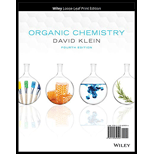
ORGANIC CHEMISTRY-PRINT COMPANION (LL)
4th Edition
ISBN: 9781119659594
Author: Klein
Publisher: WILEY
expand_more
expand_more
format_list_bulleted
Question
Chapter 7, Problem 94IP
Interpretation Introduction
Interpretation: The rapid reaction via

Concept introduction: A molecule can have both nucleophilic and electrophilic centers. An electrophilic center must be electron-deficient and can form a bond with a nucleophile. Here the nucleophile is an electron-rich species that can react with cation or any other electrophile. The
Expert Solution & Answer
Want to see the full answer?
Check out a sample textbook solution
Students have asked these similar questions
Help me understand this! Thank you in advance.
22.22 For each compound, indicate which group on the ring is more strongly activating and then
draw a structural formula of the major product formed by nitration of the compound.
Br
CHO
(a)
CH3
(b)
(c)
CHO
CH3
SO₂H
(d)
☑
OCHS
NO₂
(e)
(f)
CO₂H
NHCOCH3
NHCOCH,
(h)
CHS
22.23 The following molecules each contain two aromatic rings.
(b)
000-100-
H3C
(a)
(c)
Which ring in each undergoes electrophilic aromatic substitution more readily? Draw
the major product formed on nitration.
V
Consider this step in a radical reaction:
Br:
?
What type of step is this? Check all that apply.
Draw the products of the step on the right-hand side of the drawing area
below. If more than one set of products is possible, draw any set.
Also, draw the mechanism arrows on the left-hand side of the drawing
area to show how this happens.
⚫ionization
termination
initialization
neutralization
none of the abc
Explanation
Check
80
Ο
F3
F1
F2
2
F4
01
%
do5
$
94
#3
X
5
C
MacBook Air
25
F5
F6
66
©2025
ˇ
F7
29
&
7
8
Chapter 7 Solutions
ORGANIC CHEMISTRY-PRINT COMPANION (LL)
Ch. 7.2 - Prob. 1CCCh. 7.3 - Prob. 2CCCh. 7.3 - Prob. 1LTSCh. 7.3 - Prob. 3PTSCh. 7.3 - Prob. 4ATSCh. 7.3 - Prob. 2LTSCh. 7.3 - Prob. 5PTSCh. 7.3 - Prob. 6ATSCh. 7.3 - Prob. 7CCCh. 7.4 - Prob. 8CC
Ch. 7.5 - Prob. 9CCCh. 7.6 - Prob. 10CCCh. 7.6 - Prob. 11CCCh. 7.7 - Prob. 12PTSCh. 7.7 - Prob. 13PTSCh. 7.7 - Prob. 14ATSCh. 7.7 - Prob. 4LTSCh. 7.7 - Prob. 16ATSCh. 7.7 - Prob. 17CCCh. 7.7 - Prob. 18CCCh. 7.7 - Prob. 5LTSCh. 7.7 - Prob. 19PTSCh. 7.7 - Prob. 20ATSCh. 7.8 - Prob. 21PTSCh. 7.8 - Prob. 22ATSCh. 7.8 - Prob. 23CCCh. 7.8 - Prob. 24CCCh. 7.8 - Prob. 25CCCh. 7.8 - Prob. 26CCCh. 7.8 - Prob. 27CCCh. 7.9 - Prob. 7LTSCh. 7.9 - Prob. 29ATSCh. 7.9 - Prob. 30ATSCh. 7.9 - Prob. 31ATSCh. 7.10 - Prob. 32CCCh. 7.10 - Prob. 33CCCh. 7.10 - Prob. 34CCCh. 7.11 - Prob. 8LTSCh. 7.11 - Prob. 35PTSCh. 7.11 - Prob. 36PTSCh. 7.11 - Prob. 37ATSCh. 7.11 - Prob. 9LTSCh. 7.11 - Prob. 40PTSCh. 7.11 - Prob. 41ATSCh. 7.12 - Prob. 42CCCh. 7.12 - Prob. 43CCCh. 7.12 - Prob. 44CCCh. 7.12 - Prob. 45CCCh. 7.12 - Prob. 46CCCh. 7 - Prob. 47PPCh. 7 - Prob. 48PPCh. 7 - Prob. 49PPCh. 7 - Prob. 50PPCh. 7 - Prob. 51PPCh. 7 - Prob. 52PPCh. 7 - Prob. 53PPCh. 7 - Prob. 54PPCh. 7 - Prob. 55PPCh. 7 - Prob. 56PPCh. 7 - Prob. 57PPCh. 7 - Prob. 58PPCh. 7 - Prob. 59PPCh. 7 - Prob. 60PPCh. 7 - Prob. 61PPCh. 7 - Prob. 64PPCh. 7 - Indicate whether you would use NaOEt or tBuOK to...Ch. 7 - Prob. 68PPCh. 7 - Draw a plausible mechanism for each of the...Ch. 7 - Prob. 70PPCh. 7 - Prob. 71PPCh. 7 - Prob. 72PPCh. 7 - Prob. 73PPCh. 7 - Prob. 74PPCh. 7 - Prob. 77PPCh. 7 - Prob. 78PPCh. 7 - Prob. 81ASPCh. 7 - Prob. 87ASPCh. 7 - Prob. 90ASPCh. 7 - Prob. 91IPCh. 7 - Prob. 92IPCh. 7 - Prob. 93IPCh. 7 - Prob. 94IPCh. 7 - Prob. 95IPCh. 7 - Prob. 96IPCh. 7 - Prob. 97IPCh. 7 - Prob. 98IPCh. 7 - Prob. 99IPCh. 7 - Prob. 100IPCh. 7 - Prob. 101IPCh. 7 - Prob. 102IPCh. 7 - Prob. 103IPCh. 7 - Prob. 105IPCh. 7 - Prob. 106IPCh. 7 - Prob. 107IPCh. 7 - Prob. 109IPCh. 7 - Prob. 110CPCh. 7 - Prob. 112CPCh. 7 - Prob. 114CP
Knowledge Booster
Similar questions
- Show how to convert ethyl benzene to (a) 2,5-dichlorobenzoic acid and (b) 2,4-dichlorobenzoic acid.arrow_forwardno aiarrow_forwardPolymers may be composed of thousands of monomers. Draw three repeat units (trimer) of the polymer formed in this reaction. Assume there are hydrogen atoms there are hydrogen atoms on the two ends of the trimer. Ignore inorganic byproducts.arrow_forward
- 8:44 PM Sun Apr 13 Earn Freecash.com O Measurement and Matter =1 Setting up a unit conversion 110 Eddie says... ✰ www-awu.aleks.com A student sets up the following equation to convert a measurement. (The ? stands for a number the student is going to calculate.) Fill in the missing part of this equation. Note: your answer should be in the form of one or more fractions multiplied together. (- 4 J kJ -7.0 × 10 ☐ = ? mmol.°C mol °C x10 μ Explanation Check □·□ torox.io Grey Hill LLC. All Rightsarrow_forwardPolymers may be composed of thousands of monomers. Draw three repeat units (trimer) of the polymer formed in this reaction. Assume there are hydrogen atoms there are hydrogen atoms on the two ends of the trimer. Ignore inorganic byproducts please.arrow_forwardi need help with the folarrow_forward
arrow_back_ios
SEE MORE QUESTIONS
arrow_forward_ios
Recommended textbooks for you
 Organic ChemistryChemistryISBN:9781305580350Author:William H. Brown, Brent L. Iverson, Eric Anslyn, Christopher S. FootePublisher:Cengage Learning
Organic ChemistryChemistryISBN:9781305580350Author:William H. Brown, Brent L. Iverson, Eric Anslyn, Christopher S. FootePublisher:Cengage Learning

Organic Chemistry
Chemistry
ISBN:9781305580350
Author:William H. Brown, Brent L. Iverson, Eric Anslyn, Christopher S. Foote
Publisher:Cengage Learning